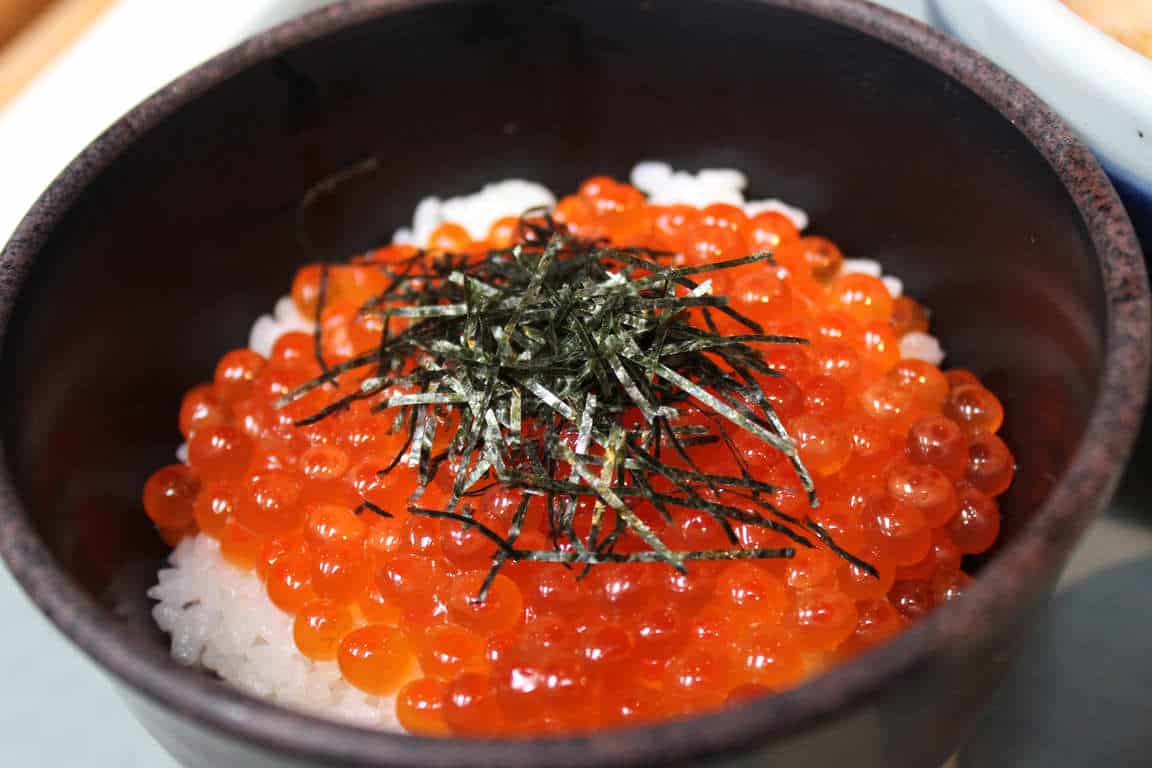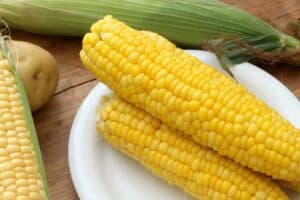Ikura or salmon roe plays a huge part in Japanese cuisine. In fact, they use salmon roe in many dishes. Not only do they use it as part of another dish, but they also eat it as it is. One of these dishes is Ikura Don, famous local food in Hokkaido.
What is Ikura Don?
Ikura Don is a Japanese rice bowl dish with pickled salmon roe on top. It is a Hokkaido traditional food that has become popular nationwide through the years. Just like ChanChanYaki, a local Hokkaido dish, Ikura Don also utilizes the high production of salmon in the area.
They usually eat Ikura Don and ChanChanYaki during the peak season of salmon fishing which is from September to October. This rice bowl dish is easy to make so it’s also a favorite among locals.

From what fish does Ikura come from?
Aside from the ranking which is determined by the maturity of the eggs, there are also two types by how loosened they are. Although both come from salmon, there’s a clear difference between the two. Even so, Autumn Salmon and Trout Salmon almost taste and look the same.
Trout Salmon is about thirty percent (30%) cheaper than Autumn Salmon. There’s also a belief that Trout Salmon is inferior to Autumn Salmon, but its taste says otherwise. The eggs of Trout Salmon are relatively smaller compared with Autumn Salmon. In addition to that, Autumn Salmon roe has a melting effect as soon as it pops. It’s also richer in taste.
What is the process of harvesting and preparing salmon eggs?
In order to harvest salmon roe, it’s important to use a coarse net to hold the eggs together. Immature eggs are also weak and prone to loosen. Therefore, it’s not suitable to process. This is also the same reason why the more mature the salmon eggs are, the higher the quality is.
In Japan, there are six rivers that record the highest production rate of salmon. Most of it can be found in Hokkaido.
Once the fishermen catch them, they will place the salmon in a mixture of crushed ice and seawater. It should stay fresh within thirty minutes. This process is extremely important in maintaining the freshness of the salmon eggs. The salmon fish die without suffering because the ice stops the rise in their body temperature.
As soon as they thaw the salmon fish, there’s a little drip of water but there’s no strong fishy smell.
Is Ikura the same with salmon roe?

While most people say that Ikura is the Japanese word for salmon roe, there’s actually a slight difference. When you say salmon roe, it refers to the developed eggs of the salmon. In Japan, they often use it in sushi and as a garnish for many dishes.
On the other hand, Ikura is also a salmon roe. However, it’s usually pickled in soy sauce or salt to enhance its flavor. Many Japanese cuisines also use Ikura in place of salt and other seasonings. Since they soak the salmon roe in salt or soy sauce, it tastes quite salty.
Ikura is also a high-quality food. As a matter of fact, some people would consider this a luxury food. It also has three different ranks, 3 special being the highest. They determine the ranks by the maturity of the eggs, color, size of the grains, and softness of the film.
Of course, Hokkaido is the largest producer of salmon roe in Japan. They are able to harvest high-quality salmon that are suitable for export. Thus, they can also supply a large amount of Ikura as well.
While Ikura means soy sauce pickled salmon roe, Sujiko is the salted salmon eggs with thin skin. On the other hand, Masuko is trout eggs that have smaller eggs and the same taste as Ikura.
History of Ikura Don
The Japanese didn’t have names for salmon ovary and salmon eggs during early times. Eventually, one person came across the name salmon roe from Russians. This encounter led the Japanese to distinguish between the salmon ovary and salmon roe. Hence, the names Sujiko and Ikura were born.

They introduced the Russian-style method of eating salmon roe during the Taisho era. Consequently, the Karafuto Agency Fisheries Experimental Station started an experiment on producing salted products. This marked the beginning of salted salmon eggs or what we know nowadays as Ikura.
Meanwhile, there is another theory that says the harvesting of salmon eggs began during the Meiji era. However, there’s not much information available regarding this. Thus, the first theory is more popular.
What does Ikura tastes like?
Of course, salmon roe has a burst of amazing flavors! So, it’s no surprise that many people love it. Salmon eggs are salty yet not overwhelming. It also has a taste of freshness and a slight sweetness. When the salmon roe is pickled in soy sauce or salt, it gives an additional kick to the overall taste of Ikura. These flavors define the unique umami of Ikura which many people crave for. To sum up, Ikura is delicious and a must-try!
Is Ikura Don healthy?

Ikura contains healthy fatty acids such as Omega 3, 6, 7, and 9. Omega 3 is famous for lowering blood pressure and reducing abnormal rhythm of the heart. Meanwhile, Omega 6 helps stimulate skin and hair growth. It can also regulate metabolism.
On the other hand, Omega 7 boosts collagen production. It also has anti-inflammatory effects on cells. While Omega 9 increases good cholesterol levels and decreases the bad. It also boosts the immune system and improves the memory health of Alzheimer’s patients.
In addition, Ikura is rich in vitamin A and protein. Vitamin A is a popular antioxidant and it can also stimulate the production of white blood cells. Furthermore, it supports bone health and lowers the risk of certain cancers.
Ikura Don Recipe
Ikura Don takes a short time to prepare. It’s so good and fulfilling as well.
Ikura Don Ingredients
| Good for 1 person | |
| salmon roe | 100 g |
| water | 2 1/ 2cups |
| white rice | 200 g |
| soy sauce | 1 tbsp. |
| salt | 1 tbsp. |
| sugar | 1 tbsp. |
| seaweed strips | appropriate amount |
| wasabi | just a little |

How to make Ikura Don?
In the first place, prepare the pickled salmon eggs by removing the sack. Then, rinse in running water and drain excess water.
Combine 1 cup of water, soy sauce, salt, and sugar in a small bowl. After that, pour the mixture on top of the salmon roe and mix well. Set aside.
As soon as the Ikura is ready, measure 200 g of rice and wash with cold water. Change the water two times so it doesn’t absorb the smell of rice bran. Then, put 1 1/2 cups of water before cooking.
When the rice is ready, scoop 1 cup of rice and put it in a clean bowl. Place the Ikura on top of the rice and sprinkle some seaweed strips. Lastly, put a small amount of wasabi on the side and serve.
Tips
- Marinating the salmon roe with a covered lid overnight makes the flavor better.
- Instead of regular steamed white rice, you can also use vinegared rice.
- Some people also add sea urchins crabs, and scallops for extra toppings.
Where to eat Ikura Don?
Hokkaido is home to many famous local dishes like Ikameshi, Jingisukan (Genghis Khan), and Soup Curry. So, there are many restaurants all around the area that offer these incredible local dishes. Check out these stores that you may want to include in your next trip.
Kitagai Cuisine Namura Bettei (北貝料理 なむら別邸)

Kitagai Cuisine Namura Bettei is accessible to Susukino Station. They have several private rooms that can cater to small groups and even larger groups of about thirty-six people (36 people). The restaurant serves different Hokkaido local dishes including Ikura Don. Thus, it’s great for company dinners and many occasions.
Kaiyotei Susukino Seafood Store (函館開陽亭 すすきの南6条本店)

Kaiyotei is also just a few steps away from Susukino Station making it a favorite among locals. In addition to that, they also have tatami rooms that are highly recommendable. Their famous Hakodate Goryokaku Course is a set meal consisting of ten dishes. Kaiyotei also offers Ikura Don and another Hokkaido local food called Jingisukan.
Kitano Gourmet (北のグルメ亭)

Kitano Gourmet is a seafood restaurant located in the Sapporo Central Wholesale Off-board Market. The store has been serving Hokkaido local food for more than seven decades now. In fact, it’s the first restaurant to open in its location. Aside from the dining experience, Kitano Gourmet also has a wide range of seafood products.
Aside from the restaurants in Sapporo, some stores in Tokyo also serve Ikura Don. Here are some of the highly-recommended restaurants that you might want to try as well.
Namino (自由が丘 波の)

This Tokyo specialty store is famous for its different types of salmon roe dishes. Of course, one of Namino’s specialties is Ikura Don. For less than 2000 yen, you can enjoy delicious salmon roe bowls. However, the shop has fifteen seats only. So, it’s best to check for reservations or to come early.
Tsujihan (つじ半 日本橋本店)

Tsujihan is a donburi restaurant that specializes in seafood bowls. They have been featured by the media several times already. At this shop, you can enjoy luxurious Ikura Don that may come with crabs and tuna for a low price. You may also request to add sea bream soup according to your preference. Since it’s a popular shop, make sure to call in for reservations before coming in.
Conclusion
Ikura Don is a traditional Japanese rice bowl topped with soy sauce pickled salmon roe. It’s a very nutritious dish that is local to Hokkaido. It’s a light yet tasty salmon dish that will surely captivate your heart!
Don’t forget to check other local dishes from Hokkaido as well. Don’t forget to like us on Facebook to get updates on our latest food recommendations!
















Comments